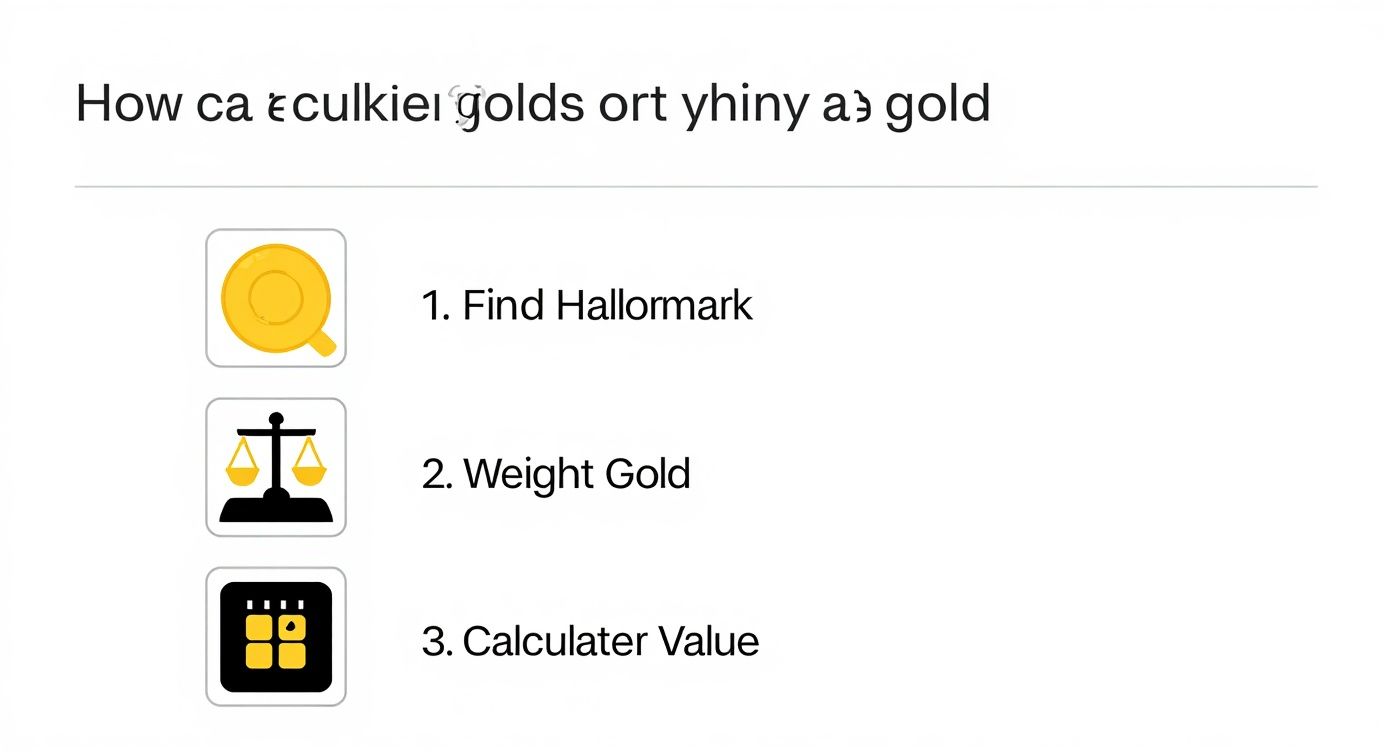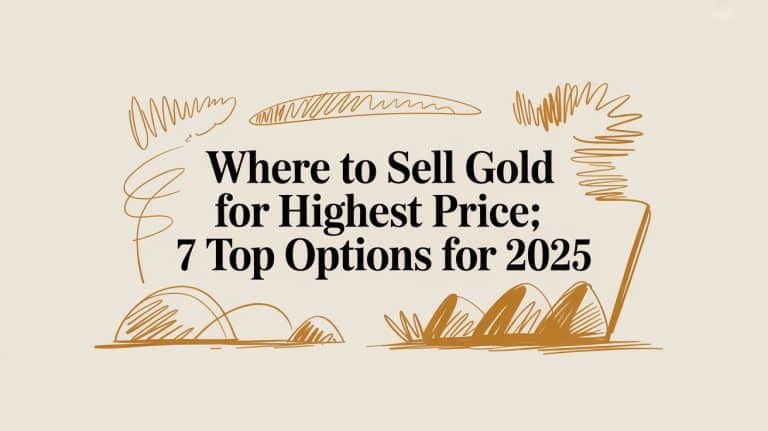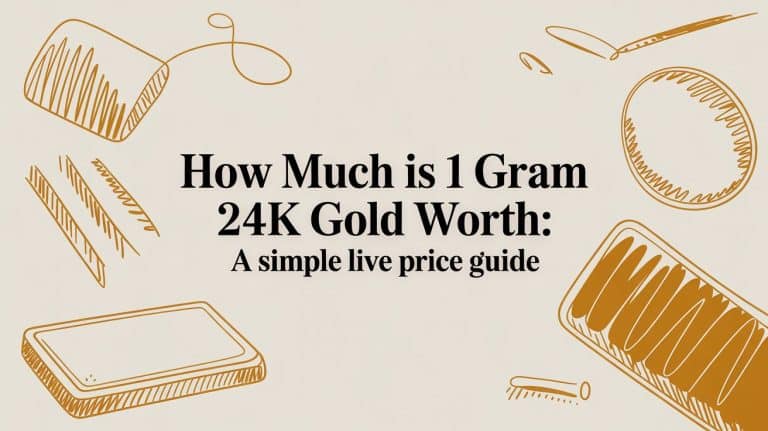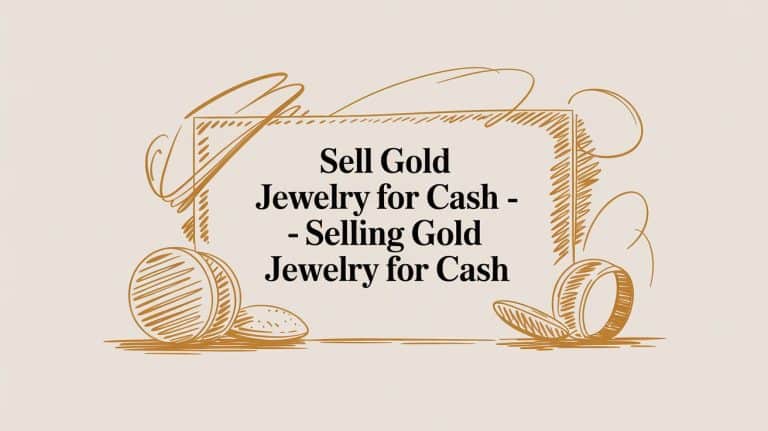Best Place to Sell Gold: Top Cash Offers & Tips
When you are looking to sell gold, the best place really comes down to your personal priorities. For most people, a reputable online gold buyer is going to put the most cash in your pocket because their lower overhead costs translate into better offers. But if you need money today or just prefer a face to face transaction, that might not be the right fit.
Your main options are specialized online buyers, local jewelry stores, and pawn shops. Each one serves a different purpose.

A Quick Guide to Selling Your Gold
Figuring out where to sell can feel like a maze, but it is really just about understanding the trade offs. You are essentially choosing between getting top dollar, getting instant cash, or the convenience of an in person deal.
The key is matching the venue to your goal. If you have a few days to spare, an online buyer will almost always give you a better return. It is simple economics they do not have the high rent and staffing costs of a brick and mortar store. This lets them work on thinner margins and offer you a higher percentage of your gold’s actual value.
On the other hand, local jewelers and pawn shops have significant daily expenses to cover, and that overhead directly eats into the amount they can afford to pay you.
Gold Selling Options At a Glance
To make this crystal clear, let’s put these options side by side. The table below breaks down how each venue typically stacks up on the factors that matter most to sellers. Think of it as a cheat sheet to quickly see which path makes the most sense for you.
| Selling Venue | Typical Payout (% of Spot Value) | Payment Speed | Convenience |
|---|---|---|---|
| Reputable Online Buyer | 80% to 95% | 2 to 5 Business Days | High (Insured mailer sent to you) |
| Local Jewelry Store | 65% to 80% | Immediate | Moderate (Requires in person visit) |
| Pawn Shop | 40% to 60% | Immediate | Moderate (Requires in person visit) |
As you can see, there is a direct trade off between the payout you receive and how quickly you get paid. You are either paying for speed with a lower offer, or you are “paying” with your time for a higher return.
The most crucial first step, regardless of where you decide to sell, is getting an independent estimate of your gold’s value. This empowers you to negotiate effectively and immediately spot a lowball offer.
Knowing what your gold is worth before you talk to a buyer changes the entire dynamic. You go from being a hopeful seller to an informed negotiator. It gives you a firm, factual baseline for the conversation and is your best defense against predatory offers. Later in this guide, we will walk through exactly how to calculate this value yourself.
How to Figure Out What Your Gold Is Really Worth
Before you even think about selling your gold, you have to know what it’s worth. Walking into a negotiation without that number is like flying blind you are completely at the mercy of the buyer’s honesty. Knowing your gold’s value first puts the power back in your hands.
The actual value of your gold jewelry or scrap items really boils down to two things: its purity (measured in karats) and its weight. A third factor, the daily spot price of gold, sets the baseline market rate. Put them all together, and you get your gold’s melt value the price a refiner would pay for just the raw precious metal inside.
Decoding Your Gold’s Purity
First things first, you need to figure out how much pure gold is in your item. Look for a tiny stamp called a hallmark, usually hidden on a clasp, inside a ring, or on the back of a pendant. You will probably need a magnifying glass to see it clearly.
These markings tell you the gold’s purity, or karat. Pure gold is 24 karat (24k), but it is far too soft for most jewelry. To make it durable enough for everyday wear, it is mixed with other metals, creating an alloy.
Here is a quick guide to what those common karat markings actually mean:
- 24k gold: This is 99.9% pure gold. You will typically see this in bullion bars or investment coins.
- 18k gold : Contains 18 parts gold and 6 parts other metals, making it 75% pure gold.
- 14k gold : The most common purity for jewelry in the U.S., it is 14 parts gold and 10 parts other metals or 58.3% pure gold.
- 10k gold : The legal minimum to be called “gold” in the U.S. It contains 10 parts gold and 14 parts other metals, making it 41.7% pure gold.
You might also see a three digit number instead of a karat marking. That is just the European system, and it represents the gold’s purity in parts per thousand (e.g., “750” is the same as 18k).
Knowing your gold’s purity is the single most important piece of the puzzle. An 18k gold chain is worth a lot more than a 14k chain of the exact same weight simply because it contains more pure gold.
Calculating Your Gold’s Melt Value
Once you know the purity, you need to weigh your items. A simple digital kitchen scale set to grams will do the trick. With the purity and weight in hand, you can figure out its baseline value.
The global markets set the “spot price” for gold, which changes constantly throughout the day. This price is always for pure, 24k gold. Your 14k or 18k items are worth a percentage of that price.
Thankfully, you do not have to do the math yourself. Using an independent tool gives you an instant, unbiased estimate to use as your negotiation anchor. For an accurate, up to the minute valuation, you can calculate your gold’s melt value with a trusted online tool.
The recent economic climate has also made this a particularly good time to assess your assets. Gold prices have seen substantial growth, creating strong conditions for sellers. In fact, gold has surged significantly in recent periods, at times hitting record highs per troy ounce. You can find more insights on gold’s market performance from sources like The World Bank.
This table shows the relationship between common hallmarks you will find and their actual gold content.
| Karat Hallmark | European Hallmark | Gold Purity Percentage |
|---|---|---|
| 24K | 999 | 99.9% |
| 22K | 916 or 917 | 91.6% |
| 18K | 750 | 75.0% |
| 14K | 583 or 585 | 58.3% |
| 10K | 417 | 41.7% |
Comparing the Top Gold Buying Venues
Alright, you have got a solid estimate of what your gold is worth. Now for the big question: where should you actually sell it? Choosing the right place is a balancing act between the final payout, how fast you get your money, and pure convenience.
You have really got three main players in this game: reputable online gold buyers, your local jewelry store, and the neighborhood pawn shop. Each one operates on a completely different business model, and that directly impacts the offer you will walk away with. Understanding why they differ is the key to picking the right one for you. A pawn shop has to buy low to cover its significant overhead, while a specialized online buyer plays a totally different game with much leaner costs.
Let’s break down how they really stack up.
This infographic lays out the first three things you absolutely must do before you even think about approaching a buyer.

Seriously, following these steps finding the hallmark, weighing the item, and calculating its melt value gives you the power in any negotiation. It is the foundation for a profitable sale.
Reputable Online Gold Buyers
Specialized online gold buyers have really taken over the market, and for one simple reason: they almost always offer the highest payouts. Think about it. They do not have the crippling costs of a retail storefront, so they can operate on much thinner margins. This lets them pass those savings directly to you with a better price. Their entire business is built around buying precious metals, making them experts at getting it done efficiently.
The process itself is pretty slick. You request a free, insured appraisal kit, pop your items in the mail with a prepaid shipping label, and get an offer within a day or two of them receiving it. If you like the number, they send your payment fast via check or direct deposit. If you do not? They ship your items right back to you, fully insured, at no cost.
Key Insight: The biggest advantage of a reputable online buyer is the bottom line. They consistently pay out between 80% and 95% of your gold’s actual melt value. That is a range most local brick and mortar shops just cannot touch.
Let’s use a real world example. Say you have a 14k gold chain that weighs 20 grams. Depending on the day’s spot price, its melt value might be around $800. A good online buyer will likely offer you between $640 and $760. This efficiency makes them the clear winner if your top priority is getting the most cash possible.
Local Jewelry Stores
Selling to a local jeweler can be a solid choice, especially if you value a face to face transaction and want cash in your hand immediately. Jewelers know their stuff and can give you a trustworthy appraisal right there on the spot. But remember, their main business is selling jewelry, not buying it, and that shapes the offers they can make.
A local jeweler has to factor in rent, staff salaries, and all the other expenses that come with a retail location. Because of this, their offers for scrap gold usually land somewhere between 65% and 80% of its melt value. For our same 20 gram 14k gold chain, a jeweler’s offer would probably be in the $520 to $640 range.
There is one situation where a jeweler might be your best bet, though. If you have a unique antique or a high end designer piece (think Tiffany & Co. or Cartier), a jeweler might see its potential for resale, not just its scrap value. In that specific case, they could offer you more than the melt value because they can sell the item as is in their display case.
Pawn Shops
Pawn shops offer the absolute fastest way to turn gold into cash, but that speed comes at a very steep price. Their entire business is built on buying items at a deep discount to ensure they can make a profit on a quick flip. For this reason, pawn shops will consistently give you the lowest payouts.
You should expect an offer from a pawn shop to be in the ballpark of 40% to 60% of your gold’s melt value. For that same $800 gold chain, a pawn shop would likely offer between $320 and $480. That is a massive difference compared to what an online buyer would pay.
While a pawn shop might be a necessary evil in a true financial emergency, it is rarely the right move if you want a fair price for your gold. The difference in payout is just too stark to ignore. For a deeper look at getting the most for your items, our guide on where to sell gold for the highest price gets into more advanced strategies.
To make these differences crystal clear, let’s look at the numbers side by side.
Comparing Payout Scenarios
This table shows the potential offers for a 14k gold chain with an estimated $800 melt value, depending on where you sell it.
| Selling Venue | Typical Payout Percentage | Estimated Offer Range | Potential Difference from Top Offer |
|---|---|---|---|
| Online Gold Buyer | 80% to 95% | $640 to $760 | $0 |
| Local Jewelry Store | 65% to 80% | $520 to $640 | $120 to $240 Less |
| Pawn Shop | 40% to 60% | $320 to $480 | $280 to $440 Less |
The numbers do not lie. The venue you choose has a dramatic impact on how much money ends up in your pocket. Unless you have a rare designer piece or are in a dire need for immediate cash, a reputable online buyer consistently offers the most value for your gold.
How to Spot Red Flags and Negotiate a Better Deal
Knowing your gold’s value is half the battle. The other half is confidently navigating the sale itself. The best place to sell your gold will always be a shop that operates with total transparency and respects that you have done your homework.
Unfortunately, not every buyer plays by those rules. Learning to spot the tell tale red flags is absolutely essential to protect yourself.
It all starts with trusting your gut. If a buyer seems rushed, dodges your questions, or pressures you into a snap decision, that is usually a sign their offer is not competitive. A reputable dealer, on the other hand, will be patient, answer everything clearly, and make sure you feel comfortable with the entire process.
Common Red Flags to Watch For
When you walk into a shop, the entire valuation process should be an open book. Any attempt to hide what they are doing is a massive warning sign. Keep an eye out for these specific behaviors if you see them, it is time to walk away.
Here are some of the most common red flags:
- Weighing Items Out of Sight: A trustworthy buyer will always weigh your gold directly in front of you. If they take your items into a back room to “test” or weigh them, that is a non negotiable deal breaker.
- Using Uncertified Scales: The scale they use should have a visible certification sticker, often from a state’s Department of Weights and Measures. This is your proof that it has been professionally calibrated and is accurate.
- Vague Purity Assessments: A professional can identify the karat of your gold in seconds. If a buyer is wishy washy, claims they “cannot tell,” or just offers a single low price for a mixed lot of different purities, they are likely trying to undervalue your higher karat items.
- High Pressure Tactics: Watch out for phrases like, “This offer is only good for right now.” This is a classic trick designed to create panic and stop you from getting a second opinion. A fair offer will still be fair an hour from now.
Recognizing these signs is your first line of defense. Remember, the global demand for physical gold has grown, especially in regions facing economic uncertainty, which has unfortunately attracted some less than reputable players. This trend is particularly strong in the Asia Pacific region, where gold is a popular hedge against currency depreciation. You can find more on this in the SSGA Midyear Gold Outlook.
How to Confidently Negotiate a Fair Price
Negotiation does not have to be a big confrontation. When you have done your homework, it is just a calm conversation aimed at reaching a fair number. Your independent valuation is the most powerful tool you have it is the factual anchor for the entire discussion.
Before you start, be sure you are confident in your own assessment. A critical part of this is knowing the purity marks on your items. If you are unsure about a hallmark, our guide on how to test gold purity can help you double check what you have.
Once you get an offer, do not just accept or reject it. Use it as the starting point for a conversation. Your goal is to understand how the buyer arrived at their price and gently guide them toward the value you already know is fair.
A fair negotiation is about aligning the buyer’s offer with the transparent market value of your gold. Your goal is not to squeeze every last penny out of them, but to ensure their offer reflects a reasonable percentage of the melt value you have already calculated.
Here is a simple framework for your negotiation, complete with sample scripts you can adapt. These phrases are polite but firm, and they immediately signal that you are an informed seller.
| Negotiation Step | What to Say | Why It Works |
|---|---|---|
| 1. Acknowledge the Offer | “Thank you for the offer of $450.” | This shows you are listening and starts the conversation on a collaborative, respectful note. |
| 2. State Your Research | “Based on my own research, I calculated the melt value of my 14k gold to be around $600.” | You have immediately introduced your independent valuation as a key data point, shifting the focus to facts. |
| 3. Ask for Their Calculation | “Could you walk me through how you arrived at your number?” | This politely asks them to justify their offer. It often reveals the percentage of melt value they are paying. |
| 4. Make a Counteroffer | “I understand you have overhead, but I was hoping to get closer to 80% of the melt value, which would be $480.” | This shows you are reasonable but firm, referencing industry standard payout rates to ground your request. |
This structured approach turns the negotiation from an emotional back and forth into a fact based discussion. It shows that you are a serious seller who understands the market, making it far more likely you will receive a revised, more competitive offer.
A Simple Framework for Choosing Where to Sell
We have covered the numbers, compared the different venues, and even talked through negotiation. Now, let’s tie it all together into a straightforward framework to help you pick the absolute best place to sell your gold based on your specific situation. There is no single right answer for everyone; it really comes down to your priorities.
Making the right call is all about balancing three key factors: payout, speed, and convenience. Once you figure out which of these matters most to you, the best option usually becomes crystal clear.

Step 1: Identify Your Top Priority
Before you do anything else, ask yourself one simple question: What do I need most from this sale? Be honest, because your answer will shape your entire strategy.
Let’s look at a few common profiles.
- Scenario A: The Maximizer: Your one and only goal is getting the highest possible cash offer. You are not in a hurry and do not mind waiting a few days to get the best price.
- Scenario B: The Sprinter: You need cash in your hand today. Speed is everything, and you are willing to take a slightly lower payout to get paid immediately.
- Scenario C: The Specialist: You have a rare antique, a signed designer piece, or a collectible coin. You know its value is more than just its weight in gold and you need a buyer who gets that.
Each of these scenarios points toward a different kind of buyer. The Maximizer should be looking at online buyers, the Sprinter should head to a local shop, and the Specialist needs an expert appraiser or a high end jeweler.
Choosing the right buyer is about aligning their business model with your personal needs. An online buyer is structured for high volume and low overhead, enabling top payouts. A pawn shop is built for immediate, collateral based transactions. A jeweler is equipped to assess resale value beyond just the raw material.
Step 2: Gather Multiple Competitive Quotes
No matter what your priority is, never accept the first offer. Getting at least two or three different quotes is non negotiable. It is the only way to know you are getting a fair price, and it gives you powerful leverage.
For The Maximizer, this means requesting free, insured appraisal kits from two or three top rated online gold buyers. Since the whole process is free, there is zero risk in getting multiple offers.
For The Sprinter, this means visiting a couple of local jewelers or pawn shops. Even if you are in a rush, spending an extra hour can easily put hundreds more dollars in your pocket.
Step 3: Make Your Decision Based on Your Priority
Once you have a few offers in hand, the final step is easy. Just look back at your top priority from Step 1 and pick the offer that fits it best.
Let’s see how this plays out for each of our scenarios.
| Your Priority & Scenario | Best Place to Sell Gold | Why This Is the Best Choice |
|---|---|---|
| Highest Payout (The Maximizer) | Reputable Online Buyer | Their business model allows for the highest payout percentages, typically 80% to 95% of melt value. The trade off is a 2 to 5 day turnaround. |
| Immediate Cash (The Sprinter) | Local Jeweler or Pawn Shop | These places offer instant payment. Jewelers usually pay more than pawn shops, but both give you on the spot cash, which is perfect for emergencies. |
| Unique/Antique Item (The Specialist) | Specialized Jeweler or Antique Dealer | These experts value an item based on its craftsmanship, brand, and history, potentially offering a price far above its melt value. |
This framework takes the guesswork out of the process. By defining what you want, getting multiple quotes, and then choosing the option that matches your goal, you can make a confident, well informed decision. It also helps to understand the bigger picture. Gold recycling is a huge part of the global gold supply, driven by demand from jewelry, investment, and technology. You can learn more about global gold demand trends to see how these forces might influence the timing of your sale.
Common Questions About Selling Gold
Even after you have done your homework, it is totally normal to have a few questions rattling around. Selling a valuable asset like gold is a big deal, and feeling certain about your decision is everything. Let’s tackle some of the most common questions sellers ask so you can move forward with total confidence.
Think of this as the last piece of the puzzle the final details you need to lock in the best possible deal for your gold.
What Percentage of Spot Price Should I Expect?
This is the big one. The answer to this question instantly separates a great buyer from a terrible one. Your goal should always be to get a payout that is a fair percentage of your gold’s melt value, also known as its spot value.
A top tier buyer, especially an online company with lower overhead, will usually pay between 75% to 90% of the melt value. Local jewelers are often a notch below that, typically offering in the 65% to 80% range. Pawn shops and those “cash for gold” roadshows? They are consistently at the bottom, sometimes paying out as little as 40% to 60%.
Be extremely wary of any offer that comes in below 70% of the calculated melt value. That is a massive red flag that the buyer is not competitive. Always get multiple quotes to make sure you are getting a fair price.
Is It Better to Sell Gold Online or In Person?
Honestly, the “best” way to sell really comes down to what you value most. There is no single right answer, just the right choice for your situation.
If your number one priority is getting the most money possible, selling online to a reputable buyer is almost always your best bet. Their business models are built on efficiency, and that efficiency translates into higher payouts. The trade off is time it usually takes a few business days from when you ship your item to when you get paid.
On the other hand, selling in person at a local jewelry store gets you paid immediately. If you need cash in your hand today, that speed can be a lifesaver. Just know that you will likely be accepting a lower offer in exchange for that convenience.
Do I Have to Pay Taxes When I Sell Gold?
Yes, in most situations, any profit you make from selling gold is considered taxable income. The IRS classifies physical gold as a “collectible,” which means any capital gains you realize from the sale are subject to tax.
The tax rate on collectibles can be higher than the rate for long term capital gains on other assets, like stocks. Tax laws are complex and depend on your personal financial situation, so it is always smart to chat with a qualified tax professional to figure out exactly what you owe.
Does Cleaning My Gold Jewelry Increase Its Value?
This is a really common myth, but the answer is a simple and firm “no.” Cleaning your gold jewelry before you sell it will not increase the offer you get.
The buyer cares about two things and two things only: the weight of your item and the purity of the gold. Since your jewelry is just going to be melted down and refined back into pure gold, what it looks like on the surface is completely irrelevant. Its shine or sparkle has zero impact on the final price. So, you can definitely save yourself the time and effort.
Here is a quick glance table to sum it all up.
| Your Question | The Short Answer | Key Takeaway |
|---|---|---|
| What is a fair payout? | 75% to 90% of melt value | Anything below 70% is likely a lowball offer. |
| Online vs. In Person? | Online for profit, in person for speed | Your top priority (money vs. time) dictates the best choice. |
| Is it taxable? | Yes, profits are taxable | Consult a tax professional to understand your specific liabilities. |
| Should I clean it first? | No, it makes no difference | The value is in the metal’s weight and purity, not its appearance. |
Ready to turn what you have learned into real money? The first step is always getting a fair, independent valuation. Use our free tools at TheGoldCalculator.com to get an instant, accurate estimate of what your gold is worth based on live market prices.







